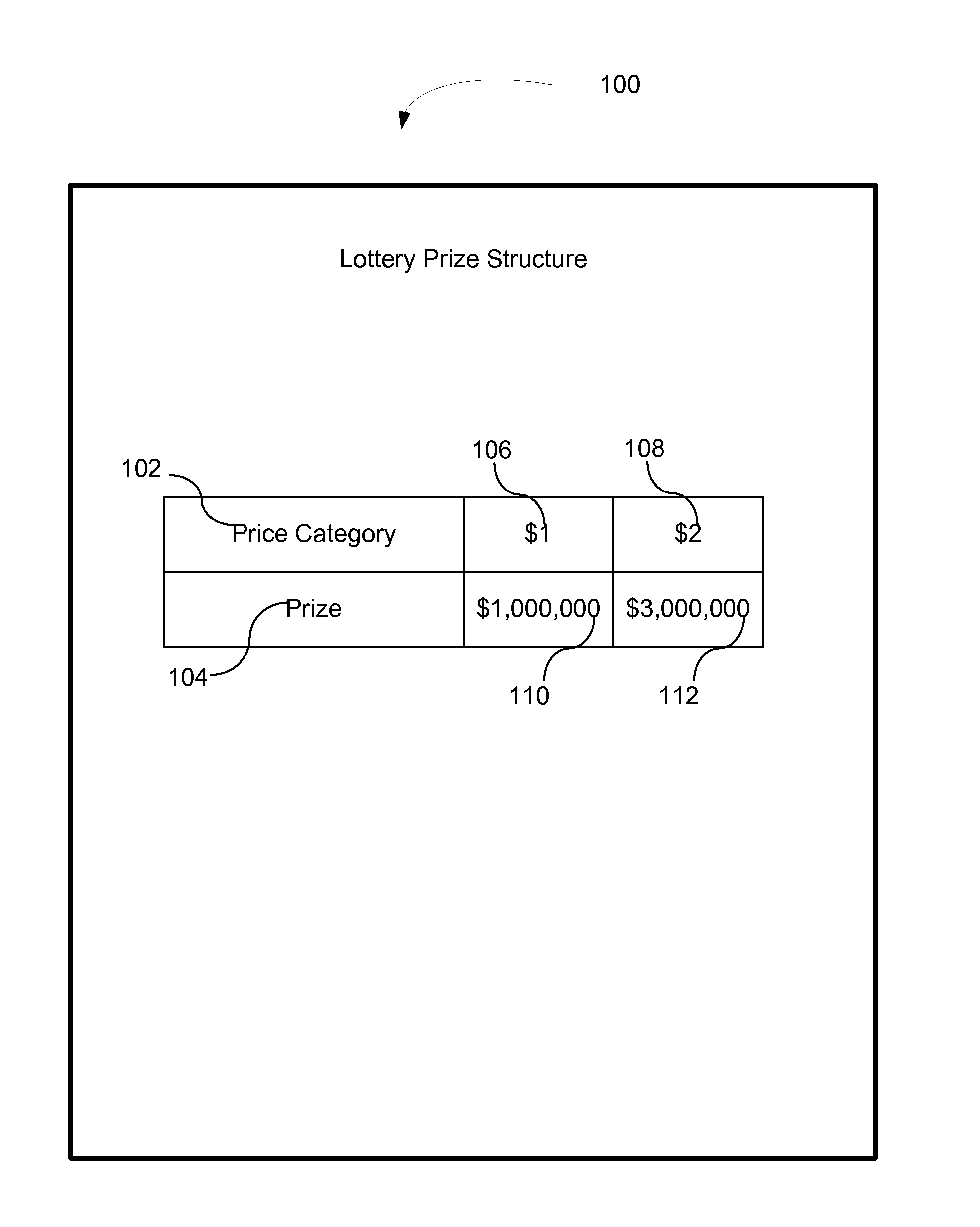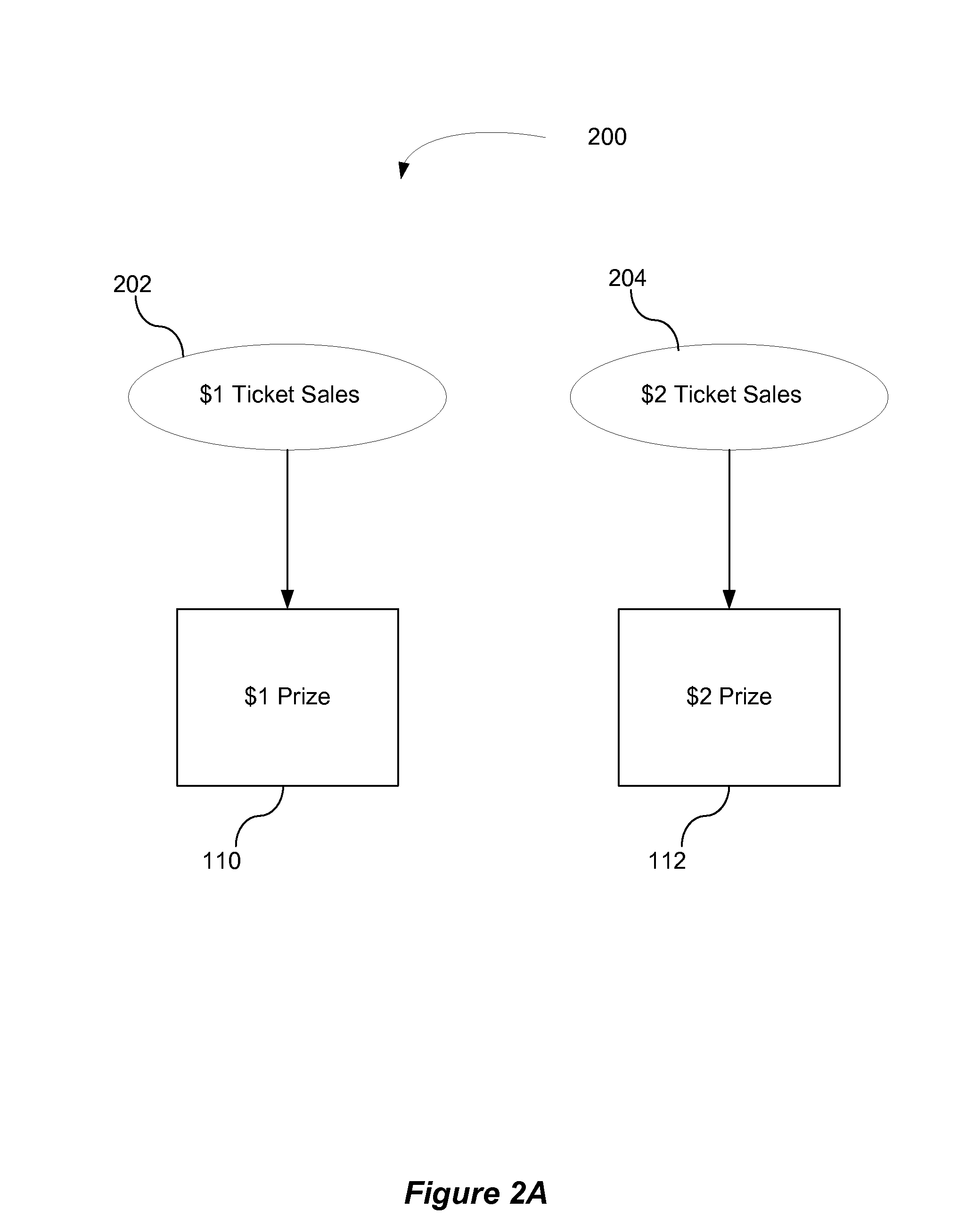[0009]In another aspect of the disclosure, a process is provided. The process establishes a first price category corresponding to a first fixed prize in a lottery game, The first fixed prize is funded from lottery ticket sales from the first price category. Further, the process establishes a second price category corresponding to a second fixed prize in the lottery game. Further, the second fixed prize is funded from lottery tickets sales from the second price category without funding from the lottery ticket sales from the first price category. In addition, the second fixed prize is greater in value than the first fixed prize. The process also determines a winning lottery number that is utilized to determine both the distribution of the first fixed prize and the distribution of the second fixed prize. Further, the process provides the distribution of the first prize to one or more players if the one or more players have a lottery ticket with the winning lottery number that is purchased from the first price category. Finally, the process provides the distribution of the second prize to one or more players if the one or more players have a lottery ticket with the winning lottery number that is purchased from the second price category.
[0010]In yet another aspect of the disclosure, a process is provided. The process establishes a first price category corresponding to a first prize in a lottery game. The first prize is funded from lottery ticket sales from the first price category. Further, the process establishes a second price category corresponding to a second prize in the lottery game. In addition, the second prize is funded from lottery tickets sales from the second price category without funding from the lottery ticket sales from the first price category. The second prize is greater in value than the first prize. The process also determines a winning lottery number that is utilized to determine both the distribution of the first prize and the distribution of the second prize. Further, the process provides the distribution of the first prize to one or more players if the one or more players have a lottery ticket with the winning lottery number that is purchased from the first price category. Finally, the process provides the distribution of the second prize to one or more players if the one or more players have a lottery ticket with the winning lottery number that is purchased from the second price category.
[0011]In another aspect of the disclosure, a process is provided. The process establishes a first price category corresponding to a first prize in a lottery game. The first prize is funded from lottery ticket sales from the first price category. Further, the process establishes a second price category corresponding to a second prize in the lottery game. In addition, the second prize is funded from lottery tickets sales from the second price category. The second prize is funded from lottery ticket sales from the first price category. Further, the second prize is greater in value than the first prize. In addition, the process determines a winning lottery number that is utilized to determine both the distribution of the first fixed prize and the distribution of the second fixed prize. The process also provides the distribution of the first prize to one or more players having a lottery ticket with the winning lottery number that is purchased from the first price category. The distribution of the first prize is an intra-shared distribution of the first prize if the one or more players having a lottery ticket with the winning lottery number that is purchased from the first price category includes multiple players. The process also provides the distribution of the second prize to one or more players have a lottery ticket with the winning lottery number that is purchased from the second price category. The distribution of the second prize is an intra-shared distribution of the second prize if the one or more players have a lottery ticket with the winning lottery number that is purchased from the second price category includes multiple players.
[0012]In another aspect of the disclosure, a process is provided. The process establishes a first price category corresponding to a first progressive jackpot prize in a lottery game. The first progressive jackpot prize is funded from lottery ticket sales from the first price category. Further, the process establishes a second price category corresponding to a second progressive jackpot prize in a lottery game such that a constant ratio is provided between the first price category and the second price category. The second progressive jackpot prize is funded from lottery ticket sales from the second price category. Further, the second progressive jackpot prize is distinct from the first progressive jackpot prize. In addition, the process establishes a third price category corresponding to a third progressive jackpot prize in the lottery game such that a variable ratio is provided between the second price category and the third price category. The third progressive jackpot prize is funded from lottery tickets sales from the third price category without funding from the lottery ticket sales from the second price category, the third progressive jackpot prize being distinct from the first progressive jackpot prize and the second progressive jackpot prize. In addition, the process determines a winning lottery number that is utilized for the first progressive jackpot prize, the second progressive jackpot prize, and the third progressive jackpot prize. Further, the process provides a distribution of the first progressive jackpot prize to one or more players if the one or more players have a lottery ticket with the winning lottery number that is purchased from the first price category. In addition, the process provides a distribution of the second progressive jackpot prize to one or more players if the one or more players have a lottery ticket with the winning lottery number that is purchased from the second price category. Finally, the process provides a distribution of the third progressive jackpot prize to one or more players if the one or more players have a lottery ticket with the winning lottery number that is purchased from the third price category.
[0013]In yet another aspect of the disclosure, a process is provided. The process establishes a first price category corresponding to a first prize in a lottery game. The first prize is funded from lottery ticket sales from the first price category without funding from lottery ticket sales from a second price category corresponding to a second prize in the lottery game. The process also establishes the second price category. Further, the second prize is funded from lottery tickets sales from the second price category without funding from the lottery ticket sales from the first price category, the second prize being greater in value than the first prize. In addition, the process determines a winning lottery number that is utilized to determine both the distribution of the first prize and the distribution of the second prize. The process provides the distribution of the first prize to one or more players if the one or more players have a lottery ticket with the winning lottery number that is purchased from the first price category. Finally, the process provides the distribution of the second prize to one or more players if the one or more players have a lottery ticket with the winning lottery number that is purchased from the second price category.
[0014]In another aspect of the disclosure, a process is provided. The process establishes a first price category corresponding to a first main prize and a first secondary prize in a lottery game. The first main prize and the first secondary prize are funded from lottery ticket sales from the first price category. The first main prize is greater than the first secondary prize. Further, the process establishes a second price category corresponding to a second prize main prize and a second secondary prize in the lottery game. The second main prize and the second secondary prize are funded from lottery tickets sales from the second price category without funding from the lottery ticket sales from the first price category. The second main prize is greater in value than the second secondary prize. The second main prize is greater in value than the first main prize. The second secondary prize is greater in value than the first secondary prize. Further, the process determines a winning lottery number that is utilized to determine a distribution of the first main prize, a distribution of the first secondary prize, a distribution of the second main prize, and a distribution of the second secondary prize. In addition, the process provides the distribution of the first main prize to one or more players if the one or more players have a lottery ticket with a full match of the winning lottery number that is purchased from the first price category. The process also provides the distribution of the first secondary prize to one or more players if the one or more players have a lottery ticket with a partial match of the winning lottery number that is purchased from the first price category. Further, the process provides the distribution of the second main prize to one or more players if the one or more players have a lottery ticket with a full match of the winning lottery number that is purchased from the second price category. In addition, the process provides the distribution of the second secondary prize to one or more players if the one or more players have a lottery ticket with a partial match of the winning lottery number that is purchased from the second price category.
 Login to View More
Login to View More  Login to View More
Login to View More 


